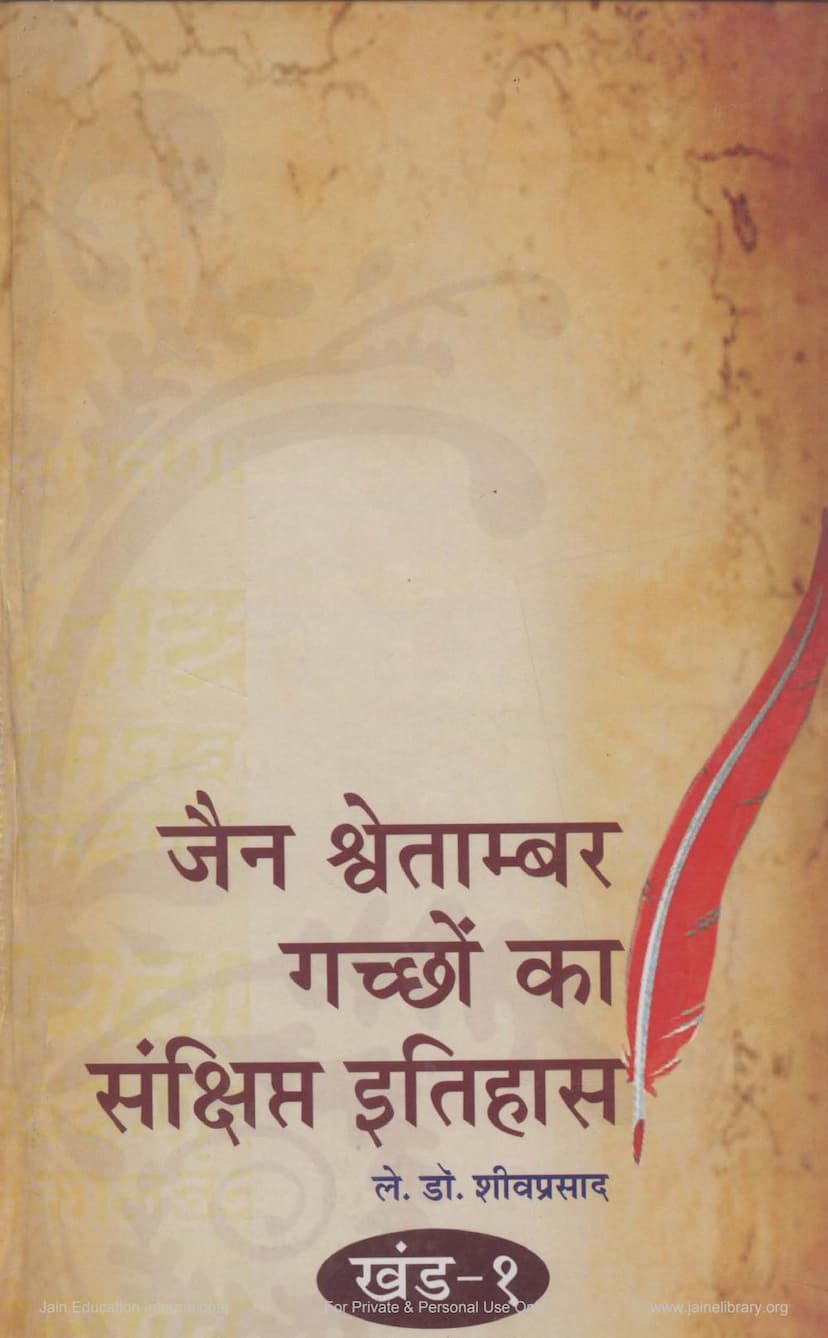Jain Shwetambar Gaccho Ka Sankshipta Itihas Part 01
Added to library: September 2, 2025

Summary
Certainly! Here's a comprehensive summary of the Jain text "Jain Shwetambar Gaccho ka Sankshipta Itihas Part 01" by Shivprasad, based on the provided pages:
Book Title: Jain Shwetambar Gaccho ka Sanksh (A Concise History of Jain Shwetambar Gacchos), Part 1 Author: Dr. Shivprasad Publisher: Aacharya Omkarsuri Gyanmandir, Surat Catalog Link: https://jainqq.org/explore/003614/1
This book, published by Aacharya Omkarsuri Gyanmandir in Surat, is the first volume of a concise history of the various gacchas (lineages or monastic orders) within the Shwetambar tradition of Jainism. The author, Dr. Shivprasad, is a dedicated researcher in this field, having previously published works on specific gacchas like the Tapagaccha and Anchalgaccha.
Core Purpose and Content:
The primary aim of this compilation is to bring together scattered information about the history of different Jain gacchas into a single, accessible volume for scholars and students. The author acknowledges that his previous articles on various gacchas published in different Jain journals have been consolidated here. The publication of this book was made possible through the generous support of the Shri Rander Road Jain Shwetambar Murtipujak Sangh, Surat, in appreciation of the Chaturmas (a four-month monastic retreat) observed by Pujya Acharya Bh. Shri Munichandrasuriji Maharaj in V.S. 2065.
Key Themes and Information Presented:
-
Historical Significance of Gaccha History: The book emphasizes the importance of understanding the history of these monastic lineages for comprehending the broader history of Jainism.
-
Author's Previous Work: Dr. Shivprasad's prior publications on the history of the Tapagaccha and Anchalgaccha are highlighted, indicating his expertise in the subject.
-
Consolidation of Dispersed Knowledge: The volume serves as a crucial resource by gathering dispersed articles and information on numerous gacchas into one place, greatly aiding researchers.
-
Dedication: The book is dedicated to the scholars and monastic figures who have contributed to preserving and presenting Jain history, specifically honoring the inspiration provided by the late Agarchandji Nahata and Bhawarlalji Nahata, and dedicating the work to the renowned art critic and historian, Prof. M.A. Dhanki.
-
Foundational Chapters:
- Chapter 1: Original Sources of Gaccha History: This chapter delves into the primary literary (book colophons, pattavalis, temple inscriptions) and archaeological (inscriptions on statues, seals, copper plates) evidence used for tracing the history of the gacchas.
- Chapter 2: The Early Form of the Shwetambar Shraman Sangh: This section discusses the initial structure and divisions within the Jain monastic order after Lord Mahavir, referencing the Sthaviravali (list of elders) found in the Paryushanakalpa (a Jain scripture). It details the various ganas, kulas, and shakhas that emerged, tracing the lineage from Gautam Swami to Devardhigani Kshamashraman. The text notes that many of these early divisions eventually merged or ceased to exist, with the Kotik gana, Chandrakula, and Vajrashakha being foundational for later gacchas.
- Chapter 3: General Introduction to the Gacchas of the Shwetambar Sect: This chapter provides an overview of how gacchas originated and were named, often based on geographical locations (e.g., Korantagaccha from Korta, Nanakeeyagaccha from Nana), specific events, or the names of influential Acharyas. It also touches upon the internal divisions and doctrinal differences that led to the formation of new gacchas, such as the Purnimapaksha (following the full moon for certain observances) and the emergence of groups like the Sthanaavasis and the Terapanth due to opposition to idol worship. The author mentions that currently, only a few gacchas like Kharatara, Tapagaccha, Anchalgaccha, and Parshwachandra (part of Tapagaccha) are still active, and the histories of the first three have already been published separately.
-
Detailed History of Numerous Gacchas: The bulk of Volume 1 provides concise historical accounts of many gacchas, listed alphabetically. The provided index lists a significant number, including:
- Addaljiya Gaccha
- Agamic Gaccha / Ancient Trishtutik Gaccha
- Upakesha Gaccha
- Kamyaka Gaccha
- Kashahad Gaccha
- Koranta Gaccha
- Krishnarshi Gaccha
- Khandila Gaccha
- Chandra Gaccha (Chandrakula)
- Chaitra Gaccha
- Jalihar Gaccha
- Jirapalli Gaccha
- Tharapadra Gaccha
- Dharmaghosh Gaccha
- Nanakeeya Gaccha
- Nagapuriya Tapagaccha
- Nagendra Gaccha
- Nivritti Kula
- Pallivala Gaccha
- Parshwachandra Gaccha
- Pippala Gaccha
- Purnatalla Gaccha
- Purnima Gaccha (and its main branch, Dhandheriya Branch, Sardha Purnima Gaccha, Purnima Paksha-Bhimpaliya Shakha)
- Brahmana Gaccha
- Brihad Gaccha
- Madahada Gaccha
- Modh Gaccha and Modh Chaitya
- Yashobhadra Suri Gaccha
- Raj Gaccha
- Wayad Gaccha
- Vidyadhar Kula / Vidyadhar Gaccha
- Sander Gaccha
- Sarvala Gaccha
- Harshpuriya Gaccha (also known as Maldhari Gaccha)
- Harija Gaccha
- And a supplementary bibliography.
Methodology and Sources:
Dr. Shivprasad relies heavily on:
- Pattavalis: Genealogies of lineage heads, which provide sequential information about Acharyas.
- Ancient Mentions: Information derived from inscriptions on anciently installed idols, stone inscriptions, and footprints.
- Ancient Copper Plate Inscriptions: Utilizing written records on copper plates.
- Praise Sections (Prashastis) of Texts: Information found at the end of ancient Jain manuscripts.
Acknowledgement of Support: The author expresses profound gratitude to Prof. M.A. Dhanki for his invaluable guidance and time, and to Mahopadhyaya Vinaysagarji and Prof. Sagarmalji for their continuous support and suggestions. He also thanks Prof. Jagdish Narayan Tiwari and Prof. Vinodchandra Srivastava for their mentorship.
Overall Significance:
This volume is a foundational work for anyone interested in the history and diversity of the Shwetambar Jain tradition. By consolidating extensive research on numerous gacchas, it provides a crucial reference point for understanding the evolution, structure, and geographical spread of these important monastic lineages. The author humbly attributes any merits of the book to the scholars who assisted him and takes responsibility for any shortcomings.